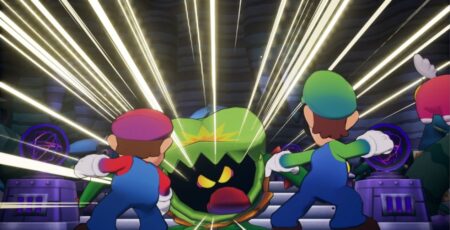
Dull Grey is an award-winning visual novel set in a stark, unforgiving world. Provodnik Games developed the game, and studio Sometimes You ported it to the Nintendo Switch. Dull Grey exists in the same universe as Provodnik Games’ previous interactive road novel, Railways of Love, but stands alone in style as well as storytelling. Dull Grey’s initial release in 2019 garnered critical acclaim and multiple awards, but I came into it completely new.
You play as Kir, a young man on the cusp of adulthood. He lives in a world defined by the Progress-Program—a government initiative that dictates every citizen’s role, station, and life trajectory. Kir’s world is illustrated in washes of grey and black. Sprawling, foggy mountains give way to lonely tundras dotted with broken-down, semi-sentient robot spiders. Buildings are pieced together with scavenged parts. A shifting soundtrack brings the landscape to life. It pulses hauntingly, punctuated by the humming and creaking of machinery and roaring geysers splitting through an impenetrable fog.
Kir’s career prospects are grim. He and the members of his family live on the outskirts of society. His mother decides it’s time to take Kir to a place called Thermal to meet the navigator, an enigmatic presence who will be the ultimate decider of Kir’s fate. Dull Grey centers on the tension between mother and son as they embark on their journey. The Progress-Program defines career options for everyone, and Mother leans into what she sees as the confines of their reality. Along with everyone around Kir, she insists that there are only two choices: will Kir become a lamplighter or a tallyman? Dull Grey repeatedly asks that same question. It’s a game with two choices. And five endings.
I’ll admit that I initially blew through my first playthrough of the game. Like Kir’s mother, I took the world of the Progress-Program at face value. When given two choices, I quickly picked one and fell in line. Like Kir’s late father, I decided I would be a lamplighter. Being a tallyman sounded a lot like being a debt collector, and I decided I’d rather try to help my community as a lamplighter rather than try to rise in the ranks of an oppressive government. As a result, Kir’s ending was acceptable. He was able to eke out a life of marginal happiness despite the boundaries placed around him. I wondered, is this it?
I played it again. And again. I learned through repetition that Dull Grey is a deceptively simple game about choice. It can feel overwhelming to push back against a system. It’s difficult to imagine a different future for yourself when everyone around you tells you what your life is allowed to look like. But Dull Grey explores what can happen in the space between a command and an answer. It embodies the power of keeping yourself open to possibilities in a world that demands you put yourself into pre-defined boxes.
Despite a couple of light typos and some choppy wording that may be more the result of losses in translation than writer error, Dull Grey is a visual novel well worth your time. It successfully delivers what every visual novel strives for—transcending words to pull the reader into its world and rewarding players who are curious and patient enough to see beneath its surface.
Dull Grey is available now for the Nintendo Switch, with future planned releases on Steam, Google Play, and the App Store in 2021.
Dull Grey
-
Rating - 8/108/10
TL;DR
Despite a couple of light typos and some choppy wording that may be more the result of losses in translation than writer error, Dull Grey is a visual novel well worth your time. It successfully delivers what every visual novel strives for—transcending words to pull the reader into its world and rewarding players who are curious and patient enough to see beneath its surface.




